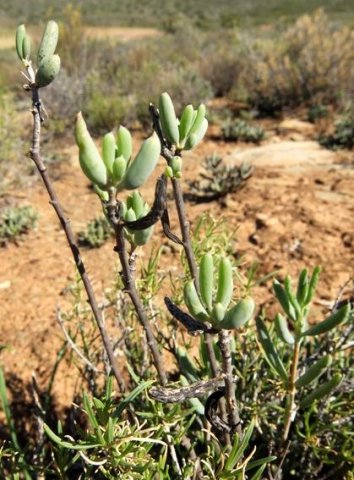Crassothonna cylindrica

Crassothonna cylindrica, one of several species called bobbejaankool (baboon cabbage) in Afrikaans, sometimes also dikblaar (thick leaf), is a loosely branched and brittle-stemmed shrub of up to 1 m in height. Until 2012 C. cylindrica was called Othonna cylindrica, until this new genus was created.
The species distribution is wide, from Namaqualand in the Northern Cape, throughout much of the Western Cape to the Eastern Cape. The plant grows among gravel in sandy or loamy soils in a diverse range of veld types. The species is not considered to be threatened in its habitat early in the twenty first century.
Nobody can become familiar with all the Asteraceae or daisy plants growing on earth. People do not live that long. There are about 20 000 species grouped in 1 100 genera to meet, each with its own set of characteristics. All the family members grow flowerheads of a number of disc and or ray florets above involucres of bracts.
Changing challenges bring further differentiation in the family through speciation, the splitting of species as conditions prompt self-inventing survival reactions, expanding diversity in the daisy community on earth.
As far as we know, no earthly daisies wonder (yet) about other daisy communities on planets elsewhere in the Milky Way or further away among (for us) inaccessible galaxies.
Their chances of making it to Mars with the first human colonists from earth are not great, as food plants will be considered first. Who knows how important flowers will be to the wellbeing of people never returning to earth?
People are more inclined to moving forward and meeting challenges like conquering space, rather than moving backwards by curbing their own excessive population numbers (Le Roux, et al, 2005; Bond and Goldblatt, 1984; iNaturalist; Wikipedia; http://redlist.sanbi.org).

